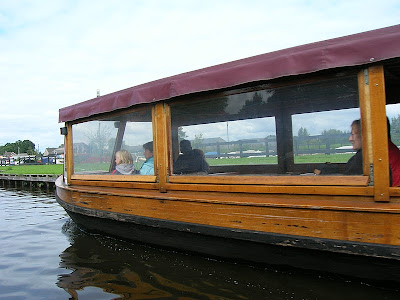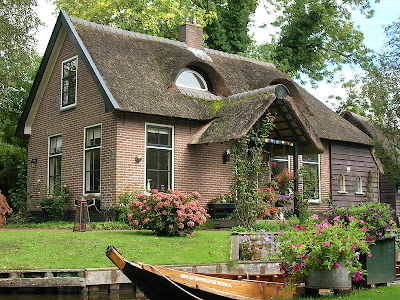Our wandering today took us to Giethoorn - the Venice of the North. Early settlers discovered that they could earn money digging peat to sell for fuel. They dug randomly wherever it was convenient, and eventually those places were flooded with water and formed canals and lakes throughout the region.
We were interested to see a man on the side of this thatched-roof home repairing the thatching.
We boarded a boat that took us through the town of Giethoorn in the most convenient way to travel - by water.
Traci catches a rare picture of Linford and I together. Usually one of us is behind the camera.
Small channels of water separated the houses from their neighbors on either side. The area had many small bridges and small watercraft to make it possible to get from street to street in the town.
It would be fun for children to play catch across the canals with their neighborhood friends.
Our guide invited us to purchase this home for the modest price of 750,000 euros - almost a million dollars. It was a little pricey for us but very attractive to look at.
All the pretty gardens and thatched- roof cottages made for a charming village. Again, the boat in the foreground shows the prevalance of canals criss-crossing the area.
We waited for this family of geese to cross the canal in front of us.
You probably wouldn't want to be a sleep walker in a town like this.
Sooo pretty!
I imagine in earlier days all the pretty footbridges didn't exist. In those days the residents would have had to rely entirely on boats to go next door to visit their neighbors.
The outskirts of the village had a mobile home area for summer vacationers.
Our driver put a measuring stick in the water to demonstrate that the lake was only about 3 feet deep. The peat-diggers had only dug down into the land far enough to harvest the peat, then a high water year floodeded the area and filled the depressions left by their digging to form man-made lakes.
However it was formed, it made for a very scenic vista.
Some tourists preferred to see the area on bicycles - a popular mode of transportation.
It would be fun to live in such a gorgeous part of Holland.
This was a popular restaurant for the many visitors who come to Giethoorn.
Apparently this home is for sale. Any takers?
We found a small cafe that served kibbeling and frites - a real Dutch fast food treat! These lovely flowers were in the courtyard where we ate our food.
All the flowers have a vibrant, rain-washed quality about them.
We left Giethoorn and next drove to Veen Park on the eastern border of Holland, almost to the German border. The windmill in the background was part of the old Dutch village on display here.
Our main reason for visiting Veen Park (Peat Park) was to learn more about the history of the peat dwellers in the 16th to 18th centuries. Since this country doesn't have enough trees to burn for fuel, peat became an important substitute. We traveled to the peat bog on this cute little tram.
We exited the tram at this location to observe the harvesting of peat.
Here we saw slabs of peat that had been set out to dry.
This man described the harvesting process and explained that different levels of excavation produced different qualities of peat. The deeper they dug below the surface, the higher the quality of fuel.
Those working the peat bogs wore special shoes and used unique equipment to handle the soggy ground.
One of the machines that were used to harvest the peat.
Our guide was very interesting as he described the entire process to our group.
At one time this would have been a very profitable business.
We headed back toward Amsterdam but decided to make a brief stop in Amersfoort to see the wall houses talked about in our guide book. We could see where a wall had been built around the city to protect it from invaders. This wasn't the first wall, however. The first wall that was built around the city became too small, so it was torn down to make a second, more spacious wall. In order to take advantage of the foundations of the old walls, homes were built on top of the wall and became known as wall houses.
We could see many circular groups of houses but weren't sure which ones were the real 'wall houses'. Oh well - it was interesting to drive through this medieval city.
As with all Dutch cities - there is always a Grote Kerk (Great Church) in the center of the city.
According to our guide book, this street contained homes built on the original city wall. You couldn't have proven it by me....they looked pretty much like every other street in the inner city.
Bye, Amersfoort. Time to head for home.



































No comments:
Post a Comment